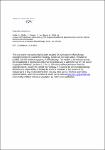A novel IS26 structure is surrounding blaCTX-M genes in different plasmids of German clinical isolates of Escherichia coli
Cullik, Angela
Pfeifer, Yvonne
Prager, Rita
Baum, Heike von
Witte, Wolfgang
This report focuses on the molecular characterization of 22 extended-spectrum beta-lactamase (ESBL) producing E. coli isolates collected in a German university hospital, during a period of nine months in 2006. Relationship analysis of clinical isolates was done via pulsed-field gel-electrophoresis, mulit-locus sequence typing, plasmid profiling and additionally PCR for blaESBL detection and phylogroups. After conjugal transfer plasmid isolation and subsequent PCR for blaESBL detection and incompatibility groups were performed. Using one-primer-walking, up to 3600 bp upstream and downstream of different blaCTX-M genes could be sequenced. Beta-Lactamases found were TEM-1 (n=14), SHV-5 (n=1) and a wide variety of CTX-M types (n=21) as CTX-M-15 (n=12), CTX-M-1 (n=4), CTX-M-14 (n=2), CTX-M-9 (n=1), CTX-M-3 (n=1) as well as one new type CTX-M-65 (n=1). In 18 isolates blaESBL genes were located on conjugative plasmids in sizes between 40 and 180 kbp belonging to incompatibility groups FII (n=9), N (n=5) andI1 (n=4). Thereby blaCTX-M were found to be associated with the commonly known elements ISEcp1, IS26 and IS903-D, but with unusual spacer sequences for ISEcp1 in two isolates. These insertion sequences connected to blaCTX-M as well as other genes were located between two IS26 elements in a composition that have not been described yet. The results reveal the emergence of blaESBL, preferentially blaCTX-M, located on different plasmids harboured by genotypic different E. coli strains. The identical gene arrangement in blaCTX-M neighbourhood in plasmids of different incompatibility groups indicates a main role of IS26 in distribution of mobile resistance elements between different plasmids.
Dateien zu dieser Publikation
Keine Lizenzangabe
Verwandte Publikationen
Anzeige der Publikationen mit ähnlichem Titel, Autor, Urheber und Thema.
-
2014-03-13ZeitschriftenartikelMortality and molecular epidemiology associated with extended-spectrum β-lactamase production in Escherichia coli from bloodstream infection Leistner, Rasmus; Sakellariou, Christian; Gürntke, Stephan; Kola, Axel; Steinmetz, Ivo; Kohler, Christian; Pfeifer, Yvonne; Eller, Christoph; Gastmeier, Petra; Schwab, FrankBackground: The rate of infections due to extended-spectrum β-lactamase (ESBL)-producing Escherichia coli is growing worldwide. These infections are suspected to be related to increased mortality. We aimed to estimate the ...
-
2017-11-13ZeitschriftenartikelRisk of Transmission of Antimicrobial Resistant Escherichia coli from Commercial Broiler and Free-Range Retail Chicken in India Hussain, Arif; Shaik, Sabiha; Ranjan, Amit; Nandanwar, Nishant; Tiwari, Sumeet K.; Majid, Mohammad; Baddam, Ramani; Qureshi, Insaf A.; Semmler, Torsten; Wieler, Lothar H.; Islam, Mohammad A.; Chakravortty, Dipshikha; Ahmed, NiyazMultidrug-resistant Escherichia coli infections are a growing public health concern. This study analyzed the possibility of contamination of commercial poultry meat (broiler and free-range) with pathogenic and or multi-resistant ...
-
2014-04-10ZeitschriftenartikelResults of surveillance for infections with Shiga toxinproducing Escherichia coli (STEC) of serotype O104:H4 after the large outbreak in Germany, July to December 2011 Frank, Christina; Milde-Busch, Astrid; Werber, DirkAfter the massive outbreak of infections with Shiga toxin-producing Escherichia coli (STEC) of serotype O104:H4 in Germany in the summer of 2011, post-outbreak surveillance for further infections with this type of STEC was ...

